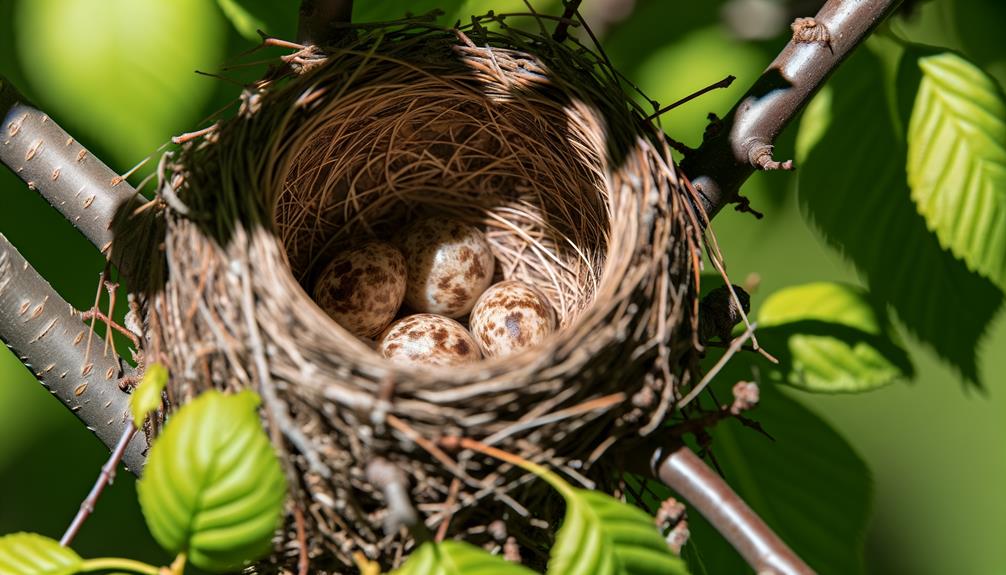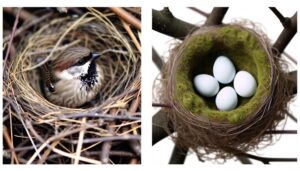How Warm Should Conditions Be for Incubating House Sparrow Eggs?
House sparrow eggs should be incubated at a precise temperature range of 37.5°C to 38.5°C. This temperature is essential for proper embryonic development and helps avoid abnormalities.
Maintaining consistent temperatures minimizes the risk of delayed development or increased mortality at lower temperatures and accelerated metabolic rates or dehydration at higher temperatures. Accurate temperature monitoring can be achieved using digital thermometers, infrared thermometers, or data loggers.
Variations from the ideal temperature can severely impact the hatchlings' health. Adjusting incubator settings and considering natural incubation methods by parent sparrows also contribute to best outcomes.
Further insights will refine your understanding of successful incubation.

Key Takeaways
- House sparrow eggs require an incubation temperature between 37.5°C and 38.5°C.
- Maintaining this temperature range is crucial for proper embryonic development.
- Deviations from the ideal temperature can cause developmental delays or mortality.
- Regular monitoring with digital or infrared thermometers is essential.
- Consistent temperature ensures optimal hatchability and chick health.
Ideal Temperature Range
The best temperature range for the incubation of house sparrow eggs is between 37.5°C and 38.5°C, as this range guarantees proper embryonic development and successful hatching. Within this ideal range, the metabolic rate of the developing embryo is maintained at a level that ensures adequate nutrient absorption and growth.
Deviations outside this temperature window can lead to developmental anomalies or embryonic mortality. At temperatures below 37.5°C, embryonic development slows down, potentially causing developmental delays. Conversely, temperatures above 38.5°C can accelerate metabolism excessively, leading to overheating and fatal stress.
Thus, maintaining the temperature within this precise range is vital for achieving high hatchability rates and safeguarding the health and viability of the house sparrow chicks.
Importance of Consistency
Maintaining a consistent incubation temperature is crucial for the successful development of house sparrow embryos. Fluctuations can disrupt metabolic processes and lead to increased mortality rates. Deviations from the best temperature range can cause reduced embryonic growth, abnormal development, and even embryonic death.
Consistency guarantees that enzymatic reactions proceed at ideal rates, supporting proper physiological and morphological development. Thermal instability can also affect the synchronization of hatching, leading to some chicks being at a developmental disadvantage.
Furthermore, consistent temperature conditions help maintain the integrity of the eggshell and membrane, critical for gas exchange and moisture retention. A stable incubation temperature is pivotal for ensuring ideal hatchability and the overall health of house sparrow chicks.
Monitoring Temperature
Monitoring temperature during the incubation of house sparrow eggs is critical to ensuring embryo development. The ideal temperature range must be consistently maintained to prevent developmental anomalies, necessitating precise temperature control.
Utilizing accurate temperature measuring tools can help achieve the necessary stability and uniformity in heat levels.
Ideal Temperature Range
Ideal incubation of house sparrow eggs requires maintaining a temperature range between 37.5°C and 38.5°C to guarantee proper embryonic development. This specific thermal window is critical for cellular processes, including mitosis and differentiation, which are highly temperature-sensitive.
Deviations from this range can result in developmental anomalies or embryonic lethality. Precise temperature control can be achieved through calibrated incubators equipped with digital thermostats and temperature probes. Regular monitoring, ideally at multiple points within the incubator, ensures uniform heat distribution.
Additionally, advanced incubators often feature alarms to alert caretakers of any fluctuations. In natural settings, the brooding behavior of the adult sparrow inherently maintains this optimal range, underscoring the importance of mimicking these conditions in artificial incubation setups.
Consistent Heat Maintenance
Accurate and consistent heat maintenance is crucial in securing successful incubation of house sparrow eggs. This necessitates the use of precise thermoregulation equipment to monitor and adjust the temperature continuously. Small fluctuations can greatly impact embryonic development, leading to potential deformities or unsuccessful hatching.
To achieve ideal results, the following practices are essential:
- Regular Monitoring: Temperature must be checked at frequent intervals to ensure uniformity.
- Temperature Stability: Maintaining a stable environment prevents thermal stress on the developing embryos.
- Calibrated Equipment: Utilizing calibrated thermoregulation devices ensures precise readings and adjustments.
- Backup Systems: Implementing alternative heating solutions can prevent temperature drops during power outages or equipment failure.
These measures contribute to a controlled and conducive environment for egg incubation.
Temperature Measuring Tools
To guarantee the exact measurement of incubation temperature, using specialized temperature measuring tools is vital. Digital thermometers, tailored for avian incubation, offer real-time and precise readings, essential for maintaining best conditions.
Infrared thermometers provide a non-contact method, allowing temperature assessment without disturbing the eggs. Temperature data loggers are invaluable for continuous monitoring, recording fluctuations that could impact development.
Additionally, hygrometers, which measure humidity, are vital since humidity levels affect temperature regulation. Combining these instruments ensures a thorough understanding of the microenvironment.
Consistent calibration and maintenance of these tools are necessary to sustain their accuracy and reliability. These methodologies enable avian biologists and conservationists to safeguard embryonic development, promoting successful hatching outcomes.
Tools for Measurement
Precise measurement of environmental conditions is essential for understanding and optimizing house sparrow egg incubation. Accurate temperature monitoring guarantees the eggs are kept within the best range for development.
Several tools can aid in this process:
- Digital Thermometers: Offer accurate and immediate temperature readings, vital for maintaining consistent conditions.
- Infrared Thermometers: Allow non-contact measurement, minimizing disturbance to the nest and eggs.
- Data Loggers: Record temperature data over time, providing a detailed view of fluctuations and trends.
- Thermocouples: Provide precise temperature readings and can be integrated into automated incubation systems for real-time monitoring.
These tools collectively guarantee that the incubation environment is maintained within the necessary parameters to support healthy embryonic development.
Common Temperature Mistakes
Despite the availability of advanced monitoring tools, several common temperature mistakes can undermine the successful incubation of house sparrow eggs. One prevalent error is the failure to maintain a consistent temperature, as even slight fluctuations can disrupt embryonic development.
Another issue is improper calibration of incubators, leading to inaccurate temperature readings. Additionally, placing the incubator in an area with poor ventilation or direct sunlight can result in uneven heating.
Over-reliance on automated systems without regular manual checks also poses risks, as technical malfunctions may go unnoticed. Finally, neglecting to account for humidity levels can exacerbate temperature control issues, further compromising egg viability.
These mistakes highlight the importance of meticulous attention to environmental conditions for best incubation outcomes.
Effects of Low Temperature
Exposure to low temperatures during the incubation period of house sparrow eggs can result in delayed embryo development. Reduced thermal energy slows metabolic processes essential for growth. Additionally, prolonged exposure to suboptimal temperatures has been correlated with increased mortality rates among embryos. This is likely due to compromised physiological functions.
Understanding these effects is vital for optimizing incubation conditions and improving hatch success rates.
Delayed Embryo Development
Low temperatures have been shown to markedly delay the development of House Sparrow embryos, impacting their overall growth and viability.
The effects of prolonged exposure to subpar incubation temperatures include:
- Extended Incubation Periods: Lower temperatures slow metabolic rates, resulting in longer incubation times.
- Subpar Physiological Development: The embryos develop more slowly, often leading to incomplete or inadequate organ formation.
- Reduced Hatching Success: Delays can lead to diminished hatching rates due to the embryo's inability to reach full term within the critical developmental window.
- Decreased Post-Hatch Fitness: Chicks that do hatch may exhibit weaker physical conditions and reduced survival skills.
These findings underscore the importance of maintaining appropriate incubation temperatures for the best development of House Sparrow embryos.
Increased Mortality Rates
The adverse effects of low incubation temperatures extend beyond delayed development, greatly contributing to increased mortality rates in House Sparrow embryos. Subpar temperatures impede normal physiological processes, leading to higher susceptibility to infections and congenital anomalies. Embryos exposed to prolonged cold periods exhibit compromised cardiovascular and respiratory systems, making survival less likely. Additionally, essential enzymatic activities critical for cellular differentiation and growth are disrupted, resulting in non-viable embryos. The following table summarizes key effects of low temperatures on House Sparrow embryos:
| Temperature (°C) | Mortality Rate (%) |
|---|---|
| 35 | 20 |
| 30 | 45 |
| 25 | 70 |
Understanding these dynamics underscores the importance of maintaining ideal incubation conditions to guarantee the viability and health of House Sparrow populations.
Effects of High Temperature
Elevated temperatures can greatly impact the incubation process of House Sparrow eggs, influencing both the rate of embryo development and hatching success. When temperatures exceed the best range, several adverse effects can be observed:
- Accelerated Metabolic Rates: High temperatures can cause an increase in the metabolic rate of embryos, potentially leading to premature hatching.
- Dehydration Risks: Excessive heat can cause water loss within the egg, leading to dehydration and subsequent embryo mortality.
- Embryonic Malformations: Prolonged exposure to elevated temperatures may result in developmental abnormalities or malformations in the chick.
- Reduced Hatching Success: Overall hatching success rates decrease as eggs subjected to high temperatures may not develop fully or hatch successfully.
Understanding these effects is important for maximizing incubation practices.
Adjusting Incubator Settings
To fine-tune incubation conditions for House Sparrow eggs, precise adjustments to incubator settings are crucial to maintaining a stable and favorable environment for embryo development.
The recommended temperature for incubating House Sparrow eggs is around 37.5°C (99.5°F), with a tolerance of ±0.1°C to prevent developmental anomalies.
Humidity levels should be kept at about 50-55% during the initial stages and increased to 65% during the hatching phase. Regular calibration of the incubator's thermostat and hygrometer is essential to ensure accurate readings.
Additionally, eggs should be turned at least three times daily to prevent the embryo from sticking to the shell membrane. Adhering to these settings promotes optimal embryonic growth and successful hatching rates.
Natural Incubation Methods
Natural incubation methods in house sparrows involve the critical role of parent sparrows in maintaining ideal conditions for egg development. These birds regulate nest temperature through behavioral adjustments, such as brooding and shading.
Additionally, natural heat sources, including sunlight and the thermal insulation provided by nest materials, contribute to maintaining consistent incubation temperatures.
Parent Sparrow Role
House sparrows exhibit a complex and highly coordinated approach to egg incubation, characterized by shared parental responsibilities and precise temperature regulation. Both the male and female sparrows are actively involved in the incubation process, ensuring ideal conditions for embryo development.
Their roles can be summarized as follows:
- Alternating Shifts: Male and female sparrows take turns incubating the eggs, allowing each parent time to forage and maintain their own health.
- Thermal Regulation: Parent sparrows use their body heat to maintain the eggs at a consistent temperature, typically around 37.5°C.
- Protective Behavior: Both parents guard the nest from potential predators, ensuring the safety of the developing embryos.
- Moisture Control: They adjust their positions and nesting materials to manage humidity levels, optimal for egg viability.
Nest Temperature Regulation
Maintaining an ideal nest temperature is crucial for the successful incubation of house sparrow eggs, necessitating a combination of behavioral and physiological strategies by both parents.
Female house sparrows exhibit brooding behavior, where they regularly sit on the eggs to transfer body heat, thereby maintaining a consistent thermal environment. The best temperature range for sparrow egg incubation is typically between 37.5°C and 38.5°C.
Males contribute by providing food, allowing females to sustain prolonged brooding periods. Additionally, nest construction with insulating materials such as feathers and grass plays an essential role in thermal regulation.
The interplay of these behaviors and nest characteristics ensures that the developing embryos receive the necessary warmth for proper growth and development.
Natural Heat Sources
In addition to the behavioral and physiological strategies employed by both parents, natural heat sources within the nest environment contribute significantly to the incubation process of house sparrow eggs. These natural sources of heat help the eggs are maintained at an ideal temperature for embryonic development.
Key natural heat sources include:
- Solar Radiation: Direct sunlight can warm the nest and eggs, especially if the nest is positioned in an exposed location.
- Nest Insulation: Materials like feathers, grasses, and leaves provide thermal insulation, trapping heat within the nest.
- Microclimate Effects: The placement of nests in sheltered areas, such as tree cavities or dense foliage, can create a microenvironment with stable temperatures.
- Body Heat: The consistent body heat from the incubating parent bird directly warms the eggs.
These factors collectively optimize the incubation conditions.
Post-Hatch Care
Once the house sparrow chicks have hatched, their survival depends greatly on the parents' diligent provisioning and protection. The adult sparrows must supply a consistent diet rich in protein, primarily comprising insects, to secure the chicks' rapid growth.
Frequent feeding intervals, approximately every 15-20 minutes, are essential during the initial days. Additionally, temperature regulation within the nest is crucial; the parents brood the chicks to maintain an ideal thermal environment.
The nestlings also require regular grooming to prevent parasite infestation, which entails the removal of fecal sacs by the parents. This meticulous care continues until the chicks fledge, typically around 14-17 days post-hatching, when they begin to develop self-sufficiency in thermoregulation and foraging.
Conclusion
To sum up, maintaining the perfect temperature range of 37.5°C to 38.0°C is essential for the successful incubation of house sparrow eggs. Consistency in temperature is equally vital, as fluctuations can greatly affect embryo development.
Importantly, studies indicate that even a 1°C deviation can decrease hatching success rates by up to 50%. Using dependable tools for temperature measurement and following best practices can reduce risks, ensuring the best conditions for the viability of the eggs and subsequent health of the hatchlings.






